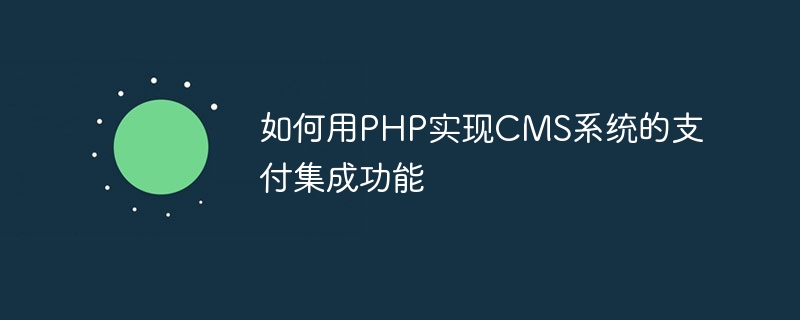

How to use PHP to implement the payment integration function of the CMS system
Introduction:
With the rapid development of e-commerce, various electronic payment methods continue to emerge. For a content management system (CMS), implementing payment integration functionality is a crucial thing. This article will use PHP language to add payment integration functions to the CMS system, and attach corresponding code examples.
1. Choose a payment integration method
Before we start writing code, we need to choose a suitable payment integration method. Commonly used payment methods include third-party payment, direct bank payment, and offline payment. Choose the appropriate payment method according to your needs and business scenarios.
2. Configure payment-related information
Add the configuration file in the PHP file, including the merchant number, key, callback address and other information of the payment platform. This information can be stored in a database or file, and you can choose the appropriate method according to the actual situation. The sample code is as follows:
$config = [
'mch_id' => '商户号',
'key' => '密钥',
'callback_url' => '回调地址'
];3. Processing payment requests and callbacks
// 处理支付请求
public function handlePaymentRequest($orderInfo, $amount)
{
// 处理并验证支付参数
// ...
// 构造支付请求数据
$requestData = [
'mch_id' => $config['mch_id'],
'amount' => $amount,
// 其他支付参数
// ...
];
// 发送请求到支付平台
$response = $this->sendPaymentRequest($requestData);
// 处理支付平台返回的结果
// ...
return $paymentResult;
}// 处理支付回调
public function handlePaymentCallback()
{
// 解析回调数据
$responseData = $this->parsePaymentCallbackData();
// 验证回调数据的有效性
// ...
// 更新订单状态
// ...
// 返回支付平台回调结果
$response = [
'code' => 200,
'msg' => 'success'
];
echo json_encode($response);
}4. Security and exception handling
When implementing the payment integration function, we also need to consider security and exception handling. This includes verification of request parameters, prevention of repeated payments, handling of abnormal situations, etc. The sample code is as follows:
// 对请求参数进行验证
public function validatePaymentRequest($requestData)
{
// 验证支付参数的合法性
// ...
// 防止重复支付
// ...
}
// 处理异常情况
public function handlePaymentException($exception)
{
// 记录异常日志
// ...
// 返回错误信息
// ...
}5. Payment result query
Sometimes, we may need to query the payment result in order to update the order status in a timely manner. In the CMS system, we can write corresponding methods to query payment results, and perform corresponding processing based on the query results. The sample code is as follows:
// 查询支付结果
public function queryPaymentResult($orderInfo)
{
// 构造查询请求数据
$requestData = [
'mch_id' => $config['mch_id'],
'order_no' => $orderInfo['order_no'],
// 其他查询参数
// ...
];
// 发送查询请求到支付平台
$response = $this->sendPaymentQueryRequest($requestData);
// 处理支付平台返回的查询结果
// ...
return $paymentResult;
}Conclusion:
Through the above steps, we can implement the payment integration function in the CMS system. Of course, the specific implementation method needs to be adjusted and improved according to your own business needs. I hope the code examples provided in this article will be helpful to you in implementing the payment integration function of your CMS system.
The above is the detailed content of How to use PHP to implement the payment integration function of CMS system. For more information, please follow other related articles on the PHP Chinese website!




